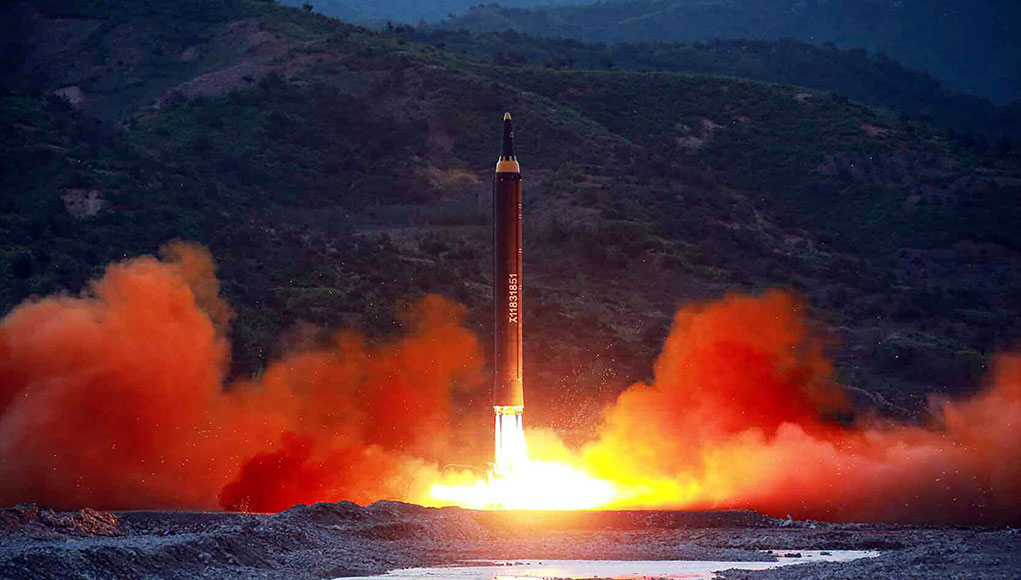North Korea’s latest successful missile test represents a new level of performance never before seen from a North Korean missile. Launched at an angle of 85 degrees, the missile reached an altitude of 2,111 km before fuel burnout. Turned earthward, the reentry vehicle turned earthward, accelerating to very high velocity to hit a designated target area in the sea of Japan, about 787 km from the launch point. The flight crossed the Korean peninsula and spanned over 26 minutes from ignition to impact.
Theoretically, if used in a Minimum Energy Trajectory (MET) such a missile would enable North Korean to strike targets as far as 4,500 km away – all the U.S. military base in Guam, Micronesia or the Russian Kuril islands near Alaska, but far from Hawaii or Alaska – the nearest US territories.
Due to the long range demonstrated in this test, the Hwaosng 12 missile (also known as KN-17) does not put South Korea or Japan at risk, but appears to have demonstrated an extended strategic reach, with an intermediate-range ballistic missile (IRBM) that might enable them to reliably strike the US base at Guam (3,500 km away).

As a single stage liquid propulsion system, Hwasong 12 may represent a substantial advance to developing an indigenous North Korean intercontinental ballistic missile (ICBM). This thrust is part of a comprehensive, strategic missile development effort that has spun over the past decade and included the development and testing of several platforms, propulsion systems, reentry vehicles and warheads, including nuclear ones.
In dozens of flight tests performed in recent years North Korean missile scientists demonstrated high level of skills, proficiency and persistence, despite major challenges they faced in obtaining key materials, engineering solutions, initially through reverse engineering and them, through continuous improvement in step-by-step trial and error, conducted under the watching eye of supreme ruler Kim Jong Un.

Pyongyang has successfully demonstrated the capability to launch different missiles, designed for deployment from fixed land based, relocatable and mobile wheeled and tracked launchers, as well as submarine-launched missiles. Different propulsion systems were also demonstrated successfully, including multi-stage liquid and solid propulsions.
The new IRBM was unveiled during last month’s parade. It looks very much like a small, two-stage version of the three-stage KN-08 ICBM prototype displayed in public in 2012. The KN-17 was displayed on a mobile launcher previously used for the Hwasong 10 “Musudan” intermediate-range ballistic missile.
While this new missile appears to share a common heritage with the KN-08 ICBM, it isn’t simply a KN-08 with the third stage removed. The first two stages also appear to be reduced in scale. Unfortunately, we have little detail about the missile’s design. We do not, for example, know if it uses the same twin-engine propulsion system as the first stage of the KN-08. But the more important question is, what is the new missile for?
One possibility is that it is meant to replace the Musudan IRBM which. represents an attempt to stretch a Cold War vintage Russian missile to reach the US base at Guam, some 3,500 km from North Korean launch sites. But the Musudan has proven unreliable in testing, with only one success in at least six attempts, and its performance is marginal for reaching Guam. The Musudan may have been the best North Korea could manage ten years ago, but that level of performance really calls for a two-stage missile. Now, it appears that they have one. But existing North Korean missiles are already capable of reaching targets anywhere in South Korea or Japan, and extending that reach to perhaps 4,500 kilometers won’t greatly change the strategic balance – aside from Guam, there aren’t really any interesting targets in that range.




















